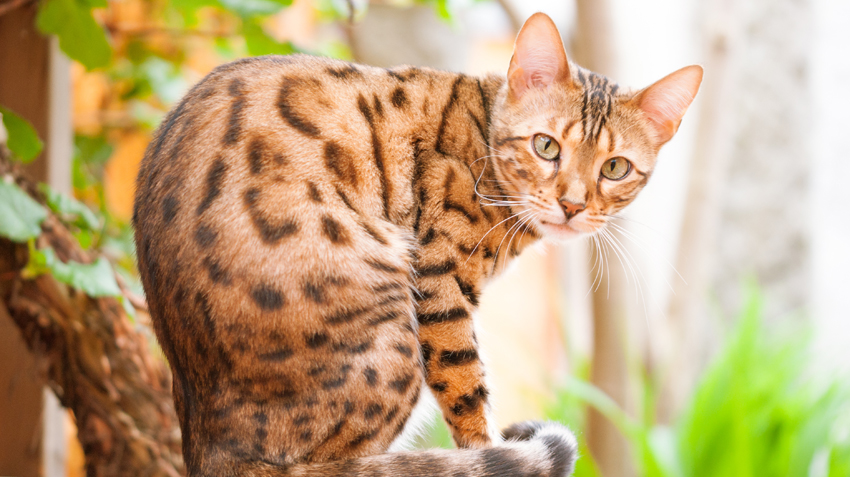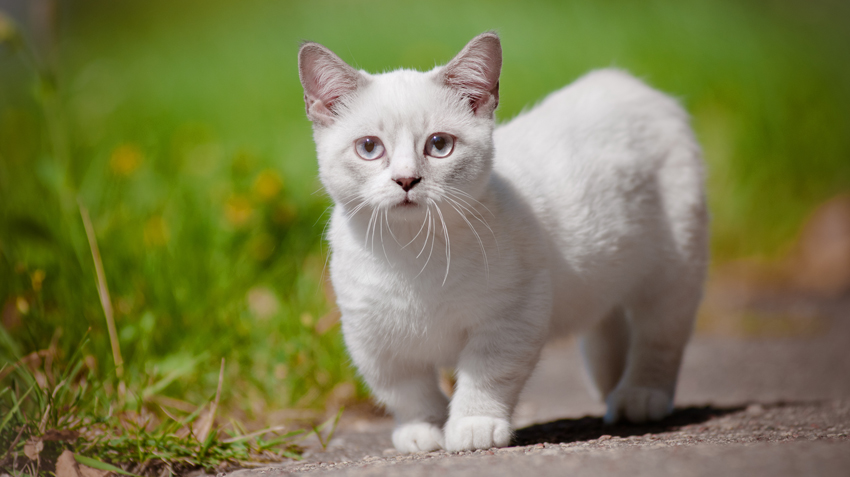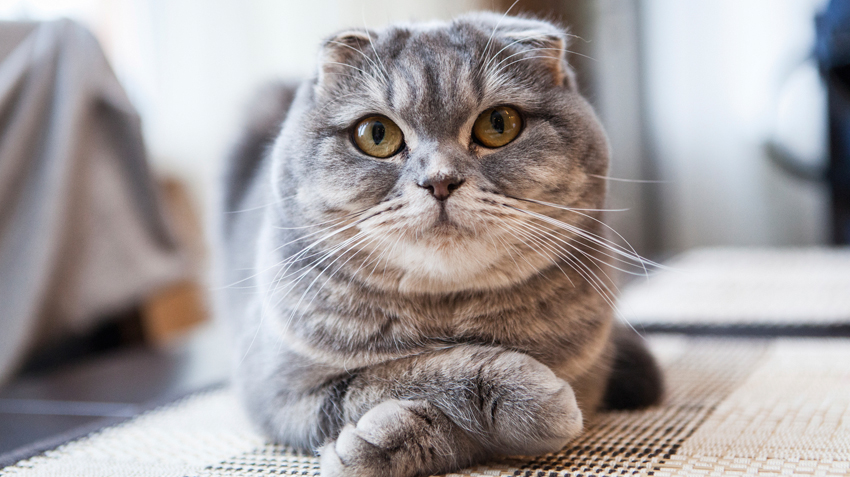Norwegian Forest Cats

Cold-Climate Cat is a Family Favorite
The Norwegian forest cat is known for its large size, expert climbing skills and its ability to withstand colder climates. Native to Northern Europe, the cat breed is rumored to have been brought to Norway by the Vikings circa 1000 A.D.
Easygoing and personable, the Norwegian forest cat has been a longtime favorite of families, particular in France, Sweden, Iceland and Norway.
 Norwegian-Forest-CatCloseup
Norwegian-Forest-CatCloseupAlthough the rumors can’t be verified, many cat fanciers believe that the Norwegian forest cat began its journey in Great Britan and traveled with Vikings and Crusaders to Norway in 1000 A.D., where they lived in Norwegian forests for hundreds of years, fine-tuning their hunting and climbing skills.
It is also speculated that the modern-day breed’s ancestors include the Siberian cat and the Turkish angora cat. Eventually, the Norwegian forest cat made its way to Norwegian farms, where they were prized for their masterful mouser skills.
By 1940, the first Norwegian Forest Cat Club was formed in an attempt to preserve the breed. The efforts became thwarted by World War II, during which famine and cross-breeding nearly rendered the breed extinct. However, the Norwegian Forest Cat Club continued their efforts following the war, creating a breeding program that once again allowed the breed to thrive.
By 1970, the Norwegian forest cat was introduced outside Norway in countries such as Sweden and England; however, it wasn’t until 1994 that the American Cat Fancier’s Association recognized the breed.
The Norwegian forest cat remains one of the most popular breeds in Norway, France and Sweden.
Norwegian forest cats, also known as “Wegies” to their families, are known to be very affectionate and easygoing, with an affinity toward children and family pets.
This intelligent breed is considered to be gentle, patient and curious, responding well to training, even tolerating walking on a leash if trained at a young age. The Norwegian forest cat even likes to fetch toys and will thrive in the company of other cats and dogs.
Norwegian forest cat owners’ most frequent suggestion to first-time owners: Buy a sturdy climbing post, or two. Not only will this help distract them from attempting to climb up (and ruin) your furniture, it will also provide them a suitable activity that will satisfy their inclination to climb.
 Norwegian-Forest-CatDuo
Norwegian-Forest-CatDuoMuch like the Maine coon, the Norwegian forest cat is a large cat, with a brawny, muscular body and long legs, weighing between 10 and 20 pounds.
Since the breed had to adapt to Norway’s cold climate, it has a thick, fluffy coat and full tail, with long, water-repellant hair and a woolly undercoat for extra insulation. As you might expect, Norwegian forest cats shed quite a bit, especially during the spring and summer months. Regular grooming will help tame the shedding.
The Norwegian forest cat coat can be in a variety of colors and patterns including tabby, patched tabby, solid and tortoiseshell. Their eyes are usually green, gold or copper.
Since the breed has a history of climbing, it should come as no surprise that it has notoriously strong claws, with the ability to climb not only trees, but rocks, too.
 Norwegian-Forest-Cat-Tabby
Norwegian-Forest-Cat-TabbyWhile these medical conditions are generally uncommon they are known to occur in the breed. Your Norwegian forest cat will not necessarily develop any of the conditions listed below. Choosing a reputable breeder from which to purchase your pet will help minimize the risks.
- Glycogen Storage Disease Type IV (also known as Andersen disease) is a neuromuscular degeneration disorder involving the processing glycogen. Although rare, it has been discovered to affect Norwegian forest cats. A DNA test is available for GSD IV and is highly recommended prior to breeding. PawPeds provides a pedigree database in which cat test results are published.
- Hip dysplasia is a hereditary malformation of the hip joint that is more commonly associated with large breed dogs but does occur in cats. It causes discomfort and lameness and results in arthritis. X-rays of the hips can help identify this problem in your cat. Proper treatment for hip dysplasia is best recommended and supervised by your veterinarian.
 Norwegian-Forest-CatCloseup
Norwegian-Forest-CatCloseupAlthough the rumors can’t be verified, many cat fanciers believe that the Norwegian forest cat began its journey in Great Britan and traveled with Vikings and Crusaders to Norway in 1000 A.D., where they lived in Norwegian forests for hundreds of years, fine-tuning their hunting and climbing skills.
It is also speculated that the modern-day breed’s ancestors include the Siberian cat and the Turkish angora cat. Eventually, the Norwegian forest cat made its way to Norwegian farms, where they were prized for their masterful mouser skills.
By 1940, the first Norwegian Forest Cat Club was formed in an attempt to preserve the breed. The efforts became thwarted by World War II, during which famine and cross-breeding nearly rendered the breed extinct. However, the Norwegian Forest Cat Club continued their efforts following the war, creating a breeding program that once again allowed the breed to thrive.
By 1970, the Norwegian forest cat was introduced outside Norway in countries such as Sweden and England; however, it wasn’t until 1994 that the American Cat Fancier’s Association recognized the breed.
The Norwegian forest cat remains one of the most popular breeds in Norway, France and Sweden.
Norwegian forest cats, also known as “Wegies” to their families, are known to be very affectionate and easygoing, with an affinity toward children and family pets.
This intelligent breed is considered to be gentle, patient and curious, responding well to training, even tolerating walking on a leash if trained at a young age. The Norwegian forest cat even likes to fetch toys and will thrive in the company of other cats and dogs.
Norwegian forest cat owners’ most frequent suggestion to first-time owners: Buy a sturdy climbing post, or two. Not only will this help distract them from attempting to climb up (and ruin) your furniture, it will also provide them a suitable activity that will satisfy their inclination to climb.
 Norwegian-Forest-CatDuo
Norwegian-Forest-CatDuoMuch like the Maine coon, the Norwegian forest cat is a large cat, with a brawny, muscular body and long legs, weighing between 10 and 20 pounds.
Since the breed had to adapt to Norway’s cold climate, it has a thick, fluffy coat and full tail, with long, water-repellant hair and a woolly undercoat for extra insulation. As you might expect, Norwegian forest cats shed quite a bit, especially during the spring and summer months. Regular grooming will help tame the shedding.
The Norwegian forest cat coat can be in a variety of colors and patterns including tabby, patched tabby, solid and tortoiseshell. Their eyes are usually green, gold or copper.
Since the breed has a history of climbing, it should come as no surprise that it has notoriously strong claws, with the ability to climb not only trees, but rocks, too.
 Norwegian-Forest-Cat-Tabby
Norwegian-Forest-Cat-TabbyWhile these medical conditions are generally uncommon they are known to occur in the breed. Your Norwegian forest cat will not necessarily develop any of the conditions listed below. Choosing a reputable breeder from which to purchase your pet will help minimize the risks.
- Glycogen Storage Disease Type IV (also known as Andersen disease) is a neuromuscular degeneration disorder involving the processing glycogen. Although rare, it has been discovered to affect Norwegian forest cats. A DNA test is available for GSD IV and is highly recommended prior to breeding. PawPeds provides a pedigree database in which cat test results are published.
- Hip dysplasia is a hereditary malformation of the hip joint that is more commonly associated with large breed dogs but does occur in cats. It causes discomfort and lameness and results in arthritis. X-rays of the hips can help identify this problem in your cat. Proper treatment for hip dysplasia is best recommended and supervised by your veterinarian.
As with any pet, be sure to regularly consult a veterinarian for routine care and medical advice for your four-legged friend.



